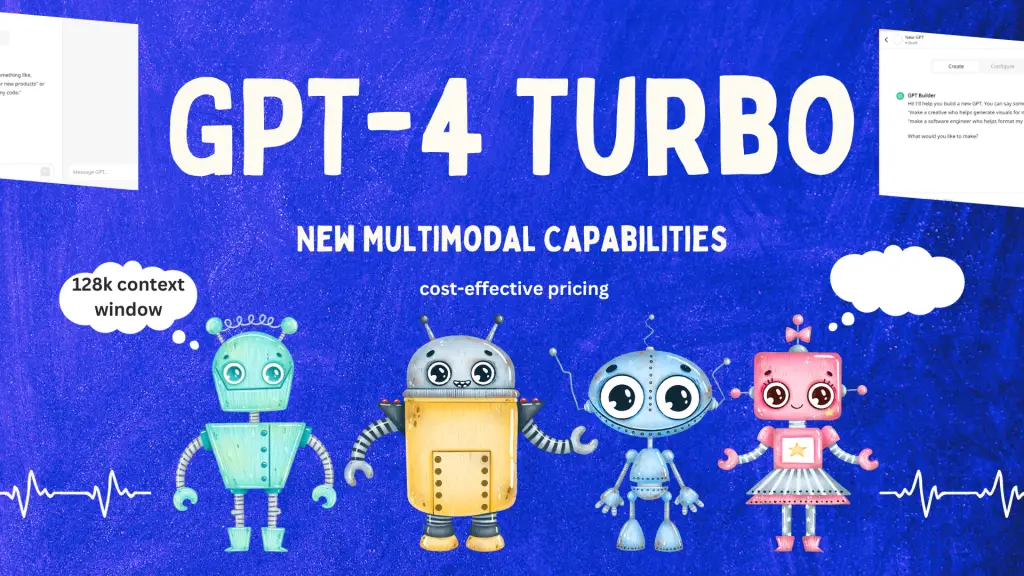Explore the latest advancements in AI with our comprehensive guide on OpenAI’s GPT-4 Turbo. Discover its enhanced capabilities, such as a 128k context window and cost-effective pricing, and learn how to access and integrate this cutting-edge technology into your projects. Understand the updated pricing structure for various GPT-4 models and stay informed about the current rate limits. Ideal for developers and tech enthusiasts keen on leveraging the power of advanced AI in their work.
In the ever-evolving world of artificial intelligence, OpenAI has consistently been at the forefront, pushing the boundaries of what’s possible. The latest announcement from OpenAI marks a significant leap in this journey: the introduction of GPT-4 Turbo and a suite of new features and tools that promise to revolutionize the AI landscape.
Table of Contents
The Dawn of GPT-4 Turbo: A New Era in AI Technology

GPT-4 Turbo is not just an incremental update; it’s a game-changer. With a 128K context window, this model can process vast amounts of text – equivalent to over 300 pages – in a single prompt. This expanded capacity ensures a deeper understanding and more nuanced responses, crucial for complex tasks and detailed analysis. Moreover, OpenAI has optimized GPT-4 Turbo to be cost-effective, making it accessible to a broader range of developers and applications.
What is GPT-4 Turbo?

GPT-4 Turbo is OpenAI’s latest generation model, offering enhanced capabilities compared to its predecessors. It stands out with an updated knowledge cutoff of April 2023 and introduces a 128k context window, capable of processing the equivalent of 300 pages of text in a single prompt. The model also boasts a cost reduction, being 3X cheaper for input tokens and 2X cheaper for output tokens compared to the original GPT-4 model. The maximum number of output tokens for this model is 4096, enabling extensive and detailed responses.
How Can I Access GPT-4 Turbo?
Access to GPT-4 Turbo is available to anyone with an OpenAI API account who already has access to GPT-4. To use this model, users simply need to pass gpt-4-1106-preview as the model name in the API. This accessibility ensures that existing users of GPT-4 can easily integrate GPT-4 Turbo into their applications.
What Are the Rate Limits? Can I Get an Increase?

The rate limits for GPT-4 Turbo are dependent on the user’s specific usage tier, which can be found on the Limits settings page of their OpenAI account. Currently, as GPT-4 Turbo is in a preview phase, OpenAI is not accommodating rate limit increases. This policy will likely remain until the stable, production-ready model is released in the coming weeks.
Empowering Developers with Advanced Tools
OpenAI’s commitment to empowering developers is evident in their new offerings. The Assistants API is a standout addition, enabling the creation of sophisticated AI assistants. These assistants are not just responsive but also proactive, capable of handling intricate tasks and providing solutions in real time.
Multimodal Capabilities: Beyond Text
In a significant leap forward, OpenAI introduces multimodal capabilities. This means GPT-4 Turbo can now process and respond to not just text but also images and speech. The integration of DALL·E 3 and text-to-speech (TTS) technologies opens up a plethora of new possibilities, from advanced image analysis to creating human-like speech from text.
Enhancing Functionality with Code Interpreter and Retrieval
The Code Interpreter and Retrieval tools are notable enhancements. The Code Interpreter allows for writing and executing Python code within a controlled environment, fostering an interactive and iterative learning and development process. The Retrieval tool, on the other hand, augments AI assistants with external knowledge, enhancing their accuracy and relevance.
Setting New Standards in Pricing and Accessibility
A crucial aspect of OpenAI’s update is the restructuring of pricing. The lower costs associated with GPT-4 Turbo make this cutting-edge technology more accessible, encouraging wider adoption and experimentation.
Updated Pricing for GPT-4: Affordable and Flexible
In an exciting development, OpenAI has introduced a new pricing model for GPT-4, aimed at making this advanced AI technology more accessible to a broader user base. As detailed by Joshua J., the new pricing structure significantly reduces the cost associated with using GPT-4, particularly in terms of prompt tokens.
GPT-4 cost?
For the standard GPT-4 models, which include the 8k context length versions like gpt-4 and gpt-4-0314, the pricing is now set at $0.03 per 1,000 prompt tokens. Additionally, the price for sampled tokens in these models is $0.06 per 1,000 tokens. This adjustment makes routine use of GPT-4 more economically viable, especially for developers and businesses that require large volumes of token usage.
Further, for the more extensive models that feature a 32k context length, such as gpt-4-32k and gpt-4-32k-0314, the pricing is slightly higher due to the increased processing capabilities. These models are priced at $0.06 per 1,000 prompt tokens and $0.12 per 1,000 sampled tokens. Despite the higher cost, the extended context length models offer enhanced capabilities, making them suitable for more complex and demanding applications.
This revised pricing structure reflects OpenAI’s commitment to making cutting-edge AI technology more attainable and adaptable for diverse applications. It opens the door for more developers, researchers, and businesses to leverage the power of GPT-4 in their projects and products, driving innovation and advancement in various fields.
Looking Ahead: The Future of AI with OpenAI
As we look to the future, it’s clear that OpenAI’s latest innovations are set to redefine the landscape of AI. From enhancing the capabilities of AI applications to making advanced technology more accessible, OpenAI is leading the way in creating a future where AI is more integrated, more intuitive, and more impactful.
Conclusion
In conclusion, the launch of GPT-4 Turbo, along with the array of new tools and features, marks a significant milestone in the field of artificial intelligence. OpenAI continues to demonstrate its commitment to innovation, empowering developers, and expanding the horizons of what AI can achieve. The future of AI looks brighter and more exciting than ever, and it’s happening right now with OpenAI’s groundbreaking advancements.
FAQs
What is GPT-4 Turbo?
GPT-4 Turbo is the latest version of OpenAI’s GPT-4 model, featuring a 128K context window and optimized performance, allowing for more efficient and cost-effective AI applications.
How is GPT-4 Turbo different from previous GPT models?
GPT-4 Turbo differs in its larger context window of 128K, enabling it to process more information in a single prompt. It’s also more cost-effective, with input and output tokens being cheaper than the previous GPT-4 model.
What are the key features of GPT-4 Turbo?
Key features include a 128K context window, optimized cost efficiency, and improved performance in tasks requiring detailed understanding and response.
What new tools does OpenAI offer with GPT-4 Turbo?
OpenAI has introduced the Assistants API, Code Interpreter, and Retrieval tools, enhancing the functionality and flexibility of AI applications.
Can GPT-4 Turbo process images and speech?
Yes, with the introduction of multimodal capabilities, GPT-4 Turbo can now process and respond to images and speech, alongside text.
What is the Assistants API and how does it work?
The Assistants API allows developers to build AI assistants with specific instructions and goals, capable of calling models and tools for a range of tasks. It provides persistent and infinitely long threads, facilitating more complex interactions.
How does the Code Interpreter tool enhance GPT-4 Turbo’s functionality?
The Code Interpreter allows the AI to write and run Python code within a sandboxed environment, enabling it to solve complex code and math problems more effectively.
What is the purpose of the Retrieval tool in GPT-4 Turbo?
The Retrieval tool augments the AI with external knowledge, like domain-specific data or user-provided documents, enhancing the AI’s response accuracy and relevance.
How has OpenAI made GPT-4 Turbo more accessible to developers?
By lowering the costs of input and output tokens, OpenAI has made GPT-4 Turbo more affordable, encouraging wider adoption among developers.


Modern Talking